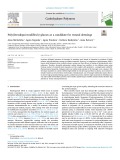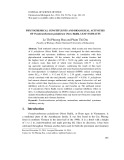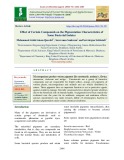
Natural melanin
-
Levodopa (biological precursor of dopamine) is sometimes used instead of dopamine for synthesis of highly adhesive polycatecholamine coatings on different materials. However, in comparison of polydopamine, little is known about biological safety of poly(levodopa) coatings and their efficacy in binding of therapeutically active substances.
 15p
15p  viginny
viginny
 30-12-2022
30-12-2022
 10
10
 4
4
 Download
Download
-
The methanol extract of P. palatiferum (Nees) Radlk. leaves exhibited a moderate inhibitory effect on the L-3,4-dihydroxyphenylalanine (L-DOPA) oxidase activity of tyrosinase in the melanin biosynthesis pathway. Further study may lead to new bioactive compounds from ethyl acetate and n-hexane fractions.
 11p
11p  tamynhan5
tamynhan5
 10-12-2020
10-12-2020
 26
26
 1
1
 Download
Download
-
Colour patterns are the most distinct phenotypic traits in the majority of the living organism including fishes and considered as one of the main influencing factors in consumers’ buying decisions. Color traits are regulated by mainly four types of pigments stored in chromatophores. Melanin, is one of the most important pigment of cells, responsible for the coloration. Tyrosinase is a characteristics enzyme in melanin biosynthesis. Modulation of tyrosinase is of significance in the ornamental fish industry, food fishes as well as in humans.
 10p
10p  caygaocaolon4
caygaocaolon4
 04-04-2020
04-04-2020
 16
16
 0
0
 Download
Download
-
Microorganisms produce various pigments like carotenoids, melanin’s, flavins, monascins, violacein and indigo. Carotenoids are a group of bioactive compounds and are responsible for bright yellow, orange, red pigments of various plants, microorganisms and animals and are widely distributed in nature. These pigments have an important function to act as protective agents against oxidative damage. Recently carotenoids have attracted greater attention due to the beneficial role on human health.
 20p
20p  trinhthamhodang4
trinhthamhodang4
 22-03-2020
22-03-2020
 7
7
 0
0
 Download
Download
-
Natural photoprotection is provided by structural proteins in the epidermis, particularly keratins and melanin. The amount of melanin and its distribution in cells is genetically regulated, and individuals of darker complexion (skin types IV–VI) are at decreased risk for the development of acute sunburn and cutaneous malignancy. Other forms of photoprotection include clothing and sunscreens. Clothing constructed of tightly woven sun-protective fabrics, irrespective of color, affords substantial protection. Wide-brimmed hats, long sleeves, and trousers all reduce direct exposure.
 6p
6p  konheokonmummim
konheokonmummim
 03-12-2010
03-12-2010
 75
75
 6
6
 Download
Download
CHỦ ĐỀ BẠN MUỐN TÌM

















